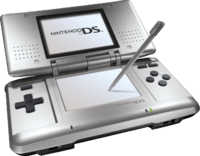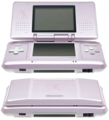Nintendo DS
ニンテンドーDS Nintendo DS | ||||||||||||||||
 Official render of the Platinum Silver Nintendo DS | ||||||||||||||||
Release dates
| ||||||||||||||||
Technical specs
| ||||||||||||||||
Related information
| ||||||||||||||||
External links
|
The Nintendo DS (Japanese: ニンテンドーDS Nintendo DS) is Nintendo's fifth series, seventh generation handheld game console. It was released on November 21, 2004 in North America, on December 2 in Japan, and on March 11, 2005 in Europe. The Nintendo DS represented an experimental new era for Nintendo's game consoles.
History
Unlike previous consoles, the Nintendo DS was not given the "Game Boy" moniker, likely because Nintendo did not want to tarnish the brand name in case of bad sales, as had happened with the earlier Virtual Boy. Marketed as a "third pillar" to Nintendo's console lineup, the DS was initially said by Nintendo not to be a replacement for the Game Boy Advance, but a partner to it.
Despite this initial strategy, however, and perhaps because of the inclusion of the secondary Game Boy Advance slot on the console itself, the DS did in fact serve as the replacement of the Game Boy Advance, and the end of the Game Boy line. Developers and gamers alike flocked to the console, which featured a significant difference from any previous gaming console: a second screen. This second screen, which doubled the real estate that developers had to work with for displaying menus and gameplay, was also touch-sensitive, and could be used to select items without pressing buttons. In addition to this, the more "standard" upgrades, such as the addition of a second speaker for true stereo sound and a microphone, were included with the console.
Most enjoyed by gamers, however, are the DS's wireless DS-to-DS and Wi-Fi capabilities, which allow gamers in close proximity to play with each other without the need for the Game Link Cable that the Game Boy line required, and for the first time, allow players to compete around the world with each other through the Nintendo Wi-Fi Connection.
Game Boy Advance games can be played on the system, with players able to set in the DS's firmware menu whether the GBA game should be played on the top or bottom screen. The GBA game will be windowboxed on the DS screen, as its resolution is slightly smaller than that of the DS. Multiplayer functions for GBA games are not supported, as the system's native wireless is different from the technology included in the wireless adapter that came included with Pokémon FireRed and LeafGreen. Game Boy and Game Boy Color games are unplayable on the system, as the processor that runs them is not included in the system, and the GBA cartridge slot will not accept them.
Like previous handhelds, the Nintendo DS later received a revised form in the smaller and sleeker Nintendo DS Lite, which shares its overall design with the Wii, and features a stronger backlight that can be set on varying brightnesses, rather than the simple on-off light the ordinary DS, called by fans the "DS Phat", has. In early 2007, the original DS was discontinued, leaving the DS Lite as the only DS on the market, until late 2008, when a second revision, the Nintendo DSi, was released. It featured a redesign of the system's menus, removed the GBA slot in favor of a smaller design, and added the ability to play music, take pictures, and more. The DSi's own revision, the Nintendo DSi XL, returns the system to the size of the DS Phat, at the same time increasing its screen size to nearly double that of the DS and DS Lite.
As of September 2008, combined sales of Nintendo DS and Nintendo DS Lite have reached more than 84 million units worldwide.[4] By the end of January 2010, that number increased to over 125 million units sold worldwide, making it Nintendo's best selling console of all time.[5]
Pokémon games
All releases listed are the year in which the Japanese version was released.
| Title | Genre | Release |
|---|---|---|
| Pokémon Dash | Racing game | 2004 |
| Pokémon Trozei! | Puzzle game | 2005 |
| Pokémon Mystery Dungeon: Blue Rescue Team | Dungeon crawler | 2005 |
| Pokémon Ranger | Action RPG | 2006 |
| Pokémon Diamond and Pearl | Core series RPG | 2006 |
| Pokémon Mystery Dungeon: Explorers of Time and Explorers of Darkness | Dungeon crawler | 2007 |
| Pokémon Ranger: Shadows of Almia | Action RPG | 2008 |
| Pokémon Platinum | Core series RPG | 2008 |
| Pokémon Mystery Dungeon: Explorers of Sky | Dungeon crawler | 2009 |
| Pokémon HeartGold and SoulSilver | Core series RPG | 2009 |
| Pokémon Ranger: Guardian Signs | Action RPG | 2010 |
| Pokémon Black and White | Core series RPG | 2010 |
| Learn with Pokémon: Typing Adventure | Typing | 2011 |
| Pokémon Card Game: How to Play DS | Card game | 2011 |
| Pokémon Conquest | Turn-based strategy | 2012 |
| Pokémon Black 2 and White 2 | Core series RPG | 2012 |
By backwards compatibility
Due to the second slot, all Game Boy Advance games can be played on the Nintendo DS and Nintendo DS Lite; however, they are incompatible with Game Boy and Game Boy Color games. Game Boy Advance games cannot be played on the Nintendo DSi or later versions due to the lack of second slot.
| Title | Genre | Release |
|---|---|---|
| Pokémon Ruby and Sapphire | Core series RPG | 2002 |
| Pokémon Pinball: Ruby & Sapphire | Pinball | 2003 |
| Pokémon FireRed and LeafGreen | Core series RPG | 2004 |
| Pokémon Emerald | Core series RPG | 2004 |
| Pokémon Mystery Dungeon: Red Rescue Team | Dungeon crawler | 2005 |
Game Boy Advance Video
Several Pokémon titles were released on Game Boy Advance Video, a series of GBA cartridges that play videos.
| Title | Genre | Release |
|---|---|---|
| Pokémon GBA Video: For Ho-Oh the Bells Toll! | Video playback | 2004 |
| Pokémon GBA Video: Johto Photo Finish | Video playback | 2004 |
| Pokémon GBA Video: Pokémon—I Choose You | Video playback | 2004 |
| Pokémon GBA Video: Beach Blank-Out Blastoise | Video playback | 2004 |
Special Pokémon editions
Trivia

- The Nintendo DS, like its predecessors (the Game Boy, Game Boy Color, and Game Boy Advance), is not region-locked. This means that a player could theoretically play a Nintendo DS game from any region on their own locally purchased console. However, games released in the People's Republic of China, which contain Chinese characters, will only run on DS systems with the iQue brand, as other versions do not have the larger microchip that supports these characters.
- In the Pokémon Adventures manga, Team Aqua used a Nintendo DS as a way for communication.
- In the Phantom Thief Pokémon 7 manga, Rocco whipped out a Nintendo DS and began to play it when he began to get bored during Drifblim's ride.
- The Nintendo DS is the best selling handheld console of all time.
- Currently, the Nintendo DS is tied with the Nintendo 3DS and Nintendo Switch for having games from the most number of generations released for it: the Generation IV and Generation V games, as well as four side games from Generation III.
External links
- Official Nintendo site (English)
- Official Nintendo site (Japanese)
References
- ↑ nintendo.co.jp
- ↑ Official Nintendo DS Launch Details | IGN
- ↑ Nintendo of Australia (archive)
- ↑ "Consolidated Financial Highlights" 11. Nintendo (2008-10-30). Retrieved on 2009-01-07.
- ↑ "IGN.com" (2010-01-28). retrieved on 2010-05-12.
| Game systems with Pokémon games |
|---|
| Nintendo handheld consoles |
| GB (Pocket · GBL · SGB · SGB2) • GBC • mini • GBA (SP · GBm · GBP) DS (Lite · DSi · DSi XL) • 3DS (XL · 2DS · New 3DS · New 3DS XL · New 2DS XL) Switch (Lite · OLED) |
| Nintendo home consoles |
| SNES (BS-X · SGB · NP · SGB2) • N64 (DD) • GCN (GBP) Wii (Family Edition · mini) • Wii U Switch (OLED) |
| Sega consoles |
| Pico • CoCoPad • Beena |



